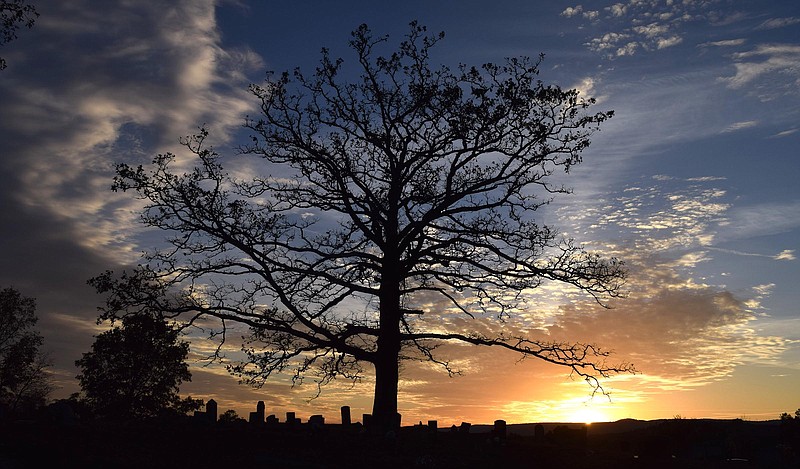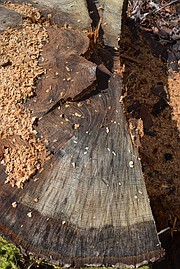When National Park Service Ranger Justin Young saw the stark stump of a poached white oak tree on the slopes of Lookout Mountain last fall, it wasn't the first theft of the species he'd seen.
Over the last several years, Young has investigated a few thefts involving large trees, but the last two involved white oaks, at least one of which was far more than a century old, cut down inside the Chattanooga city limits.
Young's investigation landed a local man in jail for a 11-month, 29-day sentence in the theft of a dozen trees last September from the slopes of Lookout Mountain on Chickamauga and Chattanooga National Military Park land. The value of the trees, restitution and associated damage totaled more than $60,000, authorities said.
Tennessee Division of Forestry officials said much of the driving force behind what appears to be an increase in white oak tree theft is the worldwide rise in popularity of Tennessee whiskey and Kentucky bourbon. Both must be stored in new white oak barrels.
(READ MORE: Hamilton County mourns fall of landmark courthouse tree)
The portion of an old white oak tree thieves usually take is the most valuable, the limbless lower trunk - called the "butt" log - and the rest they leave behind, officials said. White oak trunks are used to make staves for barrels.
Despite the recent Lookout Mountain white oak theft case on federal land, state forestry spokesperson Tim Phelps said tree theft investigations in the last year or so largely have been focused on privately owned land.
"[Over the] last one to two years, cases are widespread, but we're seeing several cases in the Cumberland Plateau region, especially with absentee landowners," he said. "Regionally, the Ag Crime Unit agent is working multiple cases."
Officials believe the increase in the theft of white oak trees now far outpaces thefts over the decades that mostly involved trees valuable in the furniture-making and milling industry thanks to a booming Tennessee whiskey and Kentucky bourbon market.
In 2013, exports of the two spirits spiked beyond $1 billion for the first time, the Distilled Spirits Council announced at the time. In September 2020, Forbes magazine reported the top five-selling whiskeys in the world, from the top down, are Tennessee's Jack Daniel's followed by bourbons Jim Beam, Evan Williams and Maker's Mark, and blended American whiskey Seagram's 7 Crown.
WHITE OAK, BOURBON AND WHISKEY
Federal law states that ''Bourbon whisky,'' ''rye whisky,'' ''wheat whisky,'' ''malt whisky" or ''rye malt whisky'' is whisky produced at not exceeding 160 proof from a fermented mash of not less than 51 percent corn, rye, wheat, malted barley, or malted rye grain, respectively, and stored at not more than 125 proof in charred new oak containers; and also includes mixtures of such whiskies of the same type. In Tennessee, in order to be called a "Tennessee whiskey" the spirits must be "aged in new, charred oak barrels in Tennessee" along with requirements that the spirits must be filtered through maple charcoal prior to aging and be placed in the barrel at no more than 125 proof, bottled at no less than 80 proof and aged in new charred oak barrels. Source: Code of Federal Regulations, Tennessee Code Annotated
Lynchburg, Tennessee-based Jack Daniel's in 2013 launched a $100 million expansion to answer the growing whiskey market.
Brown-Forman - parent company of flagship brand Jack Daniel's whiskey and popular bourbons Woodford Reserve, Old Forester and Cooper's Craft - operates a cooperage in Stevenson, Alabama, that manufactures white oak whiskey barrels. The company did not respond to a request for comment, although Young said it was instrumental in solving the Lookout Mountain theft case, helping to identify the suspect and his vehicle.
The requirements for the use of new white oak barrels for bourbon comes from the federal government, while Tennessee whiskey's requirements for new white oak barrels are a state law. The Tennessee law was signed in 2013 by then-Gov. Bill Haslam to define the spirit manufactured in the Volunteer State and protect its uniqueness.
According to TimberUpdate, a private company that posts prices of timber online, white oak logs now are worth $425 per 1,000 board feet of wood in Tennessee, exceeded only by black walnut, which brings $775 per 1,000 board feet. Other trees range in price from $55 per 1,000 board feet for yellow pine to $325 for hard sugar maple.
The Tennessee Valley Authority has been a victim of tree poachers in recent years, including not long ago when trees were cut down in the Chattanooga region, according to TVA spokesperson Scott Fiedler. Fiedler said he couldn't discuss details of the cases or even identify the species of trees taken.
"TVA police have an open and active investigation into a tree-cutting incident in Marion County and we'll prosecute to the fullest extent of the law," Fiedler said, noting cutting, injuring or otherwise taking trees from federal land, even if they're windfall trees, is illegal.
The "theft" of trees is not always criminal activity, he said.
(READ MORE: Arborist says Jackson County courthouse tree should come down as 'soon as possible')
"Unfortunately, tree-cutting on TVA land is common, but in many cases they're property owners who are our neighbors who may be cutting trees or brush and they stray onto TVA land," Fiedler said. "That's why TVA continually and routinely monitors our public lands, even very remote lands, to make sure our boundaries are accurate and visibly posted to help property owners know where the boundary is and where they should stop if they are clearing land."
TVA works with property owners who unintentionally cut trees to help them make restitution to the public, he said, and the federal agency will go after anyone who illegally and intentionally cut trees on the land the agency manages. Fiedler said TVA's natural resources team routinely does land-condition assessments looking for tree-cutting, littering, vandalism and any other kind of unauthorized use.
A branch of TVA police investigates "land-use" incidents such as tree theft, "so there's a specific division of TVA police dedicated to natural resource and issues on TVA public lands," Fiedler said.
Phelps said the problem mostly lies with private landowners who often are oblivious to thefts.
"Landowners should be vigilant in working with a private consulting forester to administer timber sales with clearly marked boundaries and clearly designated trees marked for harvest," he said of property owners with stands of marketable trees.
Landowners of property adjacent to a timber sale where logging is occurring legally should get a consulting forester's help, too, to establish the value of their timber and to closely monitor boundaries to avoid inappropriate logging from their land, he said.
"The Tennessee Division of Forestry is aware of targeted intentional theft," Phelps said, while echoing TVA's remark that not all "thefts" are intentional. "Many cases involve negligent theft - that is, trees accidentally harvested outside of an unmarked property boundary line."
The frequency of theft might depend on the remoteness or access to property, proximity to neighbors who could become witnesses to poaching or plain luck, officials said.
Jeff Holt, of natural resources management company Maple Grove Group in Oak Ridge, Tennessee, said no tree thefts have occurred on property belonging to his clients or to landowners who hire him to manage their timbered land.
"I just don't see it," Holt said. His company has managed properties for a number of absentee owners over the last several decades, mostly in an area ranging from Athens to the Cumberland Plateau and northward to Jefferson City.
"It comes up occasionally, but I've doing this in East Tennessee for 20 years and practicing more than 40," he said. "Stealing a [single] tree is really a foolish crime. Usually people log without contracts and exceed their authority or just outright trespass and take 40 acres [of trees]."
Local law enforcement doesn't always have the desire or resources to investigate such crimes, he said.
"In Tennessee, the legitimate sawmills - and almost all of them are - keep records and their records are subject to inspection by the landowner or the landowner's agent for up to a year after they've been sold. So they've got to be able to present sales records as to what they bought from whom," Holt said.
But Rob Harrison, owner of Plateau Properties in Crossville, Tennessee, says he's been a victim of white oak tree thefts twice and so far nearly 60 "nice, big white oak trees" have been stolen by a poacher or poachers.
It's a fairly new problem for him.
PENALTY IN TENNESSEE
Timber theft carries a civil penalty in Tennessee. If caught, the trespasser can be required to pay damages double or triple the current market value of the timber, according to whether the timber was negligently - accidentally - cut or knowingly - intentionally - cut from the property of another. The Tennessee Division of Forestry does not act as a landowner's agent or counsel in timber theft situations. Rather, landowners are referred to private forestry consultants for these services, officials with the state agency said.
"They've gone from nothing to we've had two different areas of theft now," Harrison said.
"When this happened I hadn't had any timber thefts to deal with. I just had a hunter come in and say 'Hey, did you know that somebody has cut a bunch of your white oak trees?' he recalled.
Illegal logging might look like easy money for some folks experiencing hard times.
"That's because prices have gone up like two to three times or more, so it's attracting opportunists looking for [trees] for whiskey barrels and for white oak lumber," Harrison said.
Thefts are not easily prevented without help, he said.
"We have some bigger tracts scattered over six counties and it's hard to keep up with properties that you can't go look at every day. We rely on neighbors and hunters to tell us if something's wrong," he said. "That's how we found out we had these thefts."
That's a good move for others.
"If they're absentee they need to cozy up to their neighbors to get them to help watch things for them," Harrison said.
Phelps agreed and suggested landowners arm themselves with information on their timber.
He said selling timber through a contract to specify which trees are to be harvested and other sale conditions can minimize the likelihood of theft. Landowners should work with a consulting forester for a "timber inventory and damage and trespass assessment" to get basic data recorded. The state forestry division maintains a directory of consulting foresters here.
Contact Ben Benton at bbenton@timesfreepress.com or 423-757-6569. Follow him on Twitter @BenBenton or at www.facebook.com/benbenton1.

